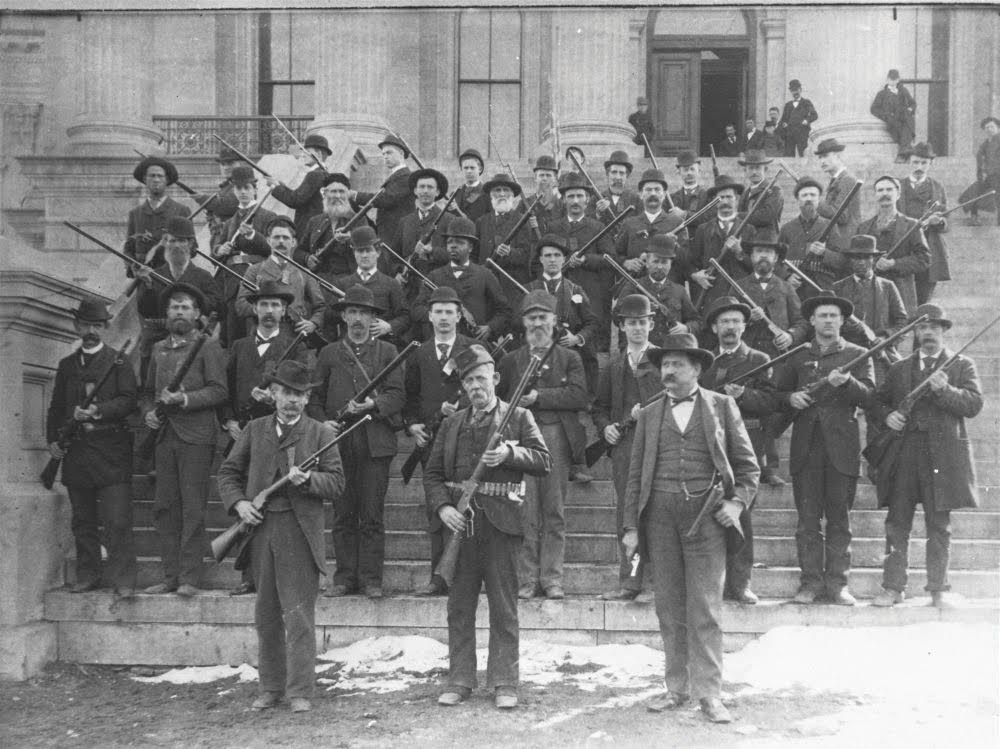by Dr. Jahue Anderson
Agrarian Revolt and the Farmer’s Alliance

Angry farmers seize the Kansas State House in Topeka. (May 20, 1891)
Agrarian Revolt
During the late 1880s, as farmers experienced their hardest years financially, several political struggles unfolded that challenged Redeemer hegemony in southern states. Through the years, farmer and labor organizations—the Virginia Readjusters, the Greenback Party, the Knights of Labor—had tried to foment change but without lasting success. Beginning in the 1860s, farmers turned to fraternal organizations, one of which was the National Grange of the Patrons of Husbandry, or the Grange.
Founded in 1867 to alleviate the farmers’ sense of isolation, increase education, and address issues of political and economic importance, such as railroad monopolies, the Grange grew to 850,000 members in 1875; 350,000 of them were in the South. Because the Grange resisted becoming involved in politics, more activist organizations like the National Farmers’ Alliance, the Colored National Farmers’ Alliance, and later the Southern Farmers’ Alliance leapt from regional to national status. Harsh economic conditions, a surplus of cotton on the world market, and a sense that state legislatures and governors only worried about their own ability to stay in power, led to the growth of the Farmers’ Alliances.
Farmers’ Alliance
In 1877, the southern Alliance movement began as a farmers’ club in Lampasas, Texas. In 1886, it came under the leadership of Texan Charles W. Macune and assumed the formal name National Farmers’ Alliance and Industrial Union but was actually known as the Southern Farmers’ Alliance. Because the Southern Farmers’ Alliance was for whites only, that same year African American farmers formed the Colored Farmers’ National Alliance and Cooperative Union in Houston County, Texas.
By 1890 these two organizations had over 2,500,000 members of which 1,000,000 belonged to the Colored Farmers’ Union. Macune called for farmers’ cooperatives and founded the Texas State Exchange in Dallas for the buying of farm supplies and the selling of non-perishable crops at the best prices for farmers, but the cooperatives failed due to lack of capital. Farmers in the South suffered not only from falling prices but also from a downward spiral in the money supply that made currency more valuable and this made it harder to pay off loans taken from lenders years before.
Farmers complained that they were the victims of inequitable taxes, high interest and railroad rates, high tariffs on the goods they bought, and an unsympathetic government, which they felt could relieve their economic distress. They formalized their complaints in the Ocala (Florida) Platform of the National Farmers’ Alliance, resolved in 1890, calling primarily for: an increase in money circulation to no less than $50 per person, removal of heavy tariffs, the free and unlimited coinage of silver, the government ownership of railroads and the telegraph (means of public communication and transportation), a graduated income tax, and the direct election of United State senators.
Perhaps the most telling demand from farmers came in the form of the sub-treasury system, a plan to create cooperative warehouses similar to those imagined by Charles Macune that would store non-perishable farm products, such as cotton and corn, and hold the crops back from immediate sale at harvest time until the prices rose sometime in the following year. Financed by interest fees and federal taxes, the plan would provide a loan to farmers by the federal treasury at 80% of the market value of the crop. Farmers would repay the government, one hoped after a profit, with a small interest fee. Additionally, the plan called for providing farmers with affordable financing and increasing the supply of circulating currency. The plan never materialized in its suggested form, but in 1933 New Deal legislators created the Agricultural Adjustment Act, which served the same purpose: to create scarcity to raise farm prices.
Later adopted as part of the Populist platform, Alliance members also called for the use of fiat money, or greenbacks, issued directly by the government to increase the per capita money supply to the target of $50. This would require going off the gold standard and returning to the greenback system that had been used with considerable success by the Union during the Civil War.
